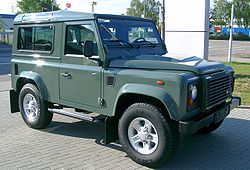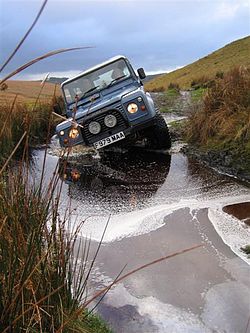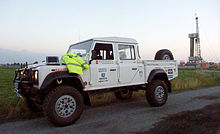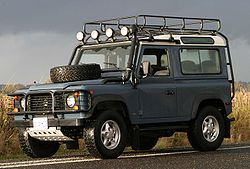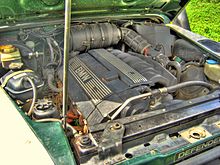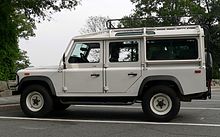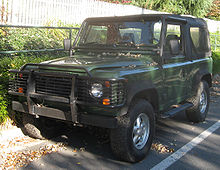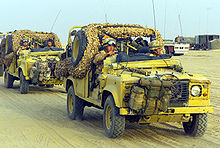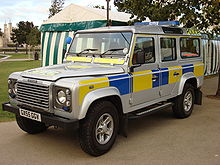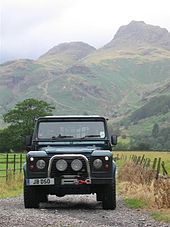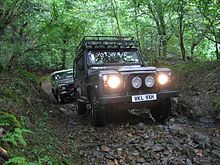- Land Rover Defender
-
Land Rover Defender
2007 DefenderManufacturer Land Rover Also called Land Rover Ninety, One Ten & 127 (1983-1990) Production 1983-present Assembly Solihull, West Midlands, England, United Kingdom
Shah Alam, Malaysia (SMA)[1]
Istanbul, Turkey (Otokar)[2]
Aqaba, Jordan (LRAAP; CKD)
Thika, Kenya (KVM)[3]Predecessor Land Rover Series Class Off-road vehicle Layout Front engine, four-wheel drive The Land Rover Defender (initially called the Land Rover Ninety and Land Rover One Ten) is a British four wheel drive off-road utility vehicle developed from the original Land Rover Series launched in 1948.
Contents
Name and badge distinctions
The model was introduced in 1983 as the Land Rover Ninety and the Land Rover One Ten, the numbers representing the wheelbase in inches. The number was spelt out in full in advertising and in handbooks and manuals, and the vehicles also carried badges above the radiator grille which read "Land Rover 90" or "Land Rover 110", with the number rendered numerically. The Ninety and One Ten replaced the earlier Land Rover Series, and at the time of launch, the only other Land Rover model in production was the Range Rover.
In 1989, a third model was brought out by Land Rover to be produced in parallel with the other two: the Land Rover Discovery. To avoid possible confusion, from 1991 the Ninety and the One Ten were renamed the Defender 90 and Defender 110. These carried front badges that say "Defender", with a badge on the rear of the vehicle saying "Defender 90" or "Defender 110". The current model, from 2007, still has the space above the radiator for the badge, but this is simply blank, and they have "Land Rover" spelt out across the leading edge of the bonnet in raised individual letters. At the rear is a new '"Defender" badge with an underlining "swoosh". On these current models there are no badges defining the wheelbase model of the vehicle.
The 127-inch (3,226 mm) wheelbase Land Rover 127 available from 1985 was always marketed with the name rendered numerically. Following the adoption of the Defender name, it became the Defender 130, although the wheelbase remained unchanged.
North American Specification (NAS) Defenders sold between 1993 and 1997 said only "Land Rover" with no "90" or "110" numeric designation.
Land Rover Ninety & One Ten
Ninety, One Ten & 127 Production 1983–1990 Body style 3-door station wagon (Ninety)
5-door station wagon (One Ten)
2-door pickup (Ninety)
3-door van (Ninety).Engine 2.3 l 75 hp (56 kW) I4 petrol (1983–1985)
2.3 l 62 hp (46 kW) I4 diesel (1983)
2.5 l 68 hp (51 kW) I4 diesel (1984–1993)
2.5 L 83 hp (62 kW) I4 petrol (1985–1993)
2.5 L 85 hp (63 kW) I4 Turbodiesel (1986–1990)
3.5 l 113 hp (84 kW) V8 (1983–1986)
3.5 l 134 hp (100 kW) V8 (1986–1993)Transmission LT95 4-speed manual (One Ten early V8 engines only)
LT77 5-speed manual
LT85 5-speed manual (Ninety and One Ten V8)Wheelbase 92.9 in (2,360 mm) (Ninety)
110 in (2,794 mm) (One Ten)
127 in (3,226 mm) (127)Length 160.5 in (4,077 mm) (Ninety)
181.1 in (4,600 mm) (One Ten)Width 70.5 in (1,791 mm) Height 80.2 in (2,037 mm) (Ninety)
84 in (2,134 mm) (One Ten)Related Land Rover Wolf
Santana PS-10Production of the model now known as the Defender began in 1983 as the Land Rover One Ten, a name which reflected the 110-inch (2,800 mm) length of the wheelbase. The Land Rover Ninety, with 93-inch (2,362 mm) wheelbase, and Land Rover 127, with 127-inch (3,226 mm) wheelbase, soon followed.[4]
Outwardly, there is little to distinguish the post-1983 vehicles from the Series III Land Rover. A full-length bonnet, revised grille, plus the fitting of wheel arch extensions to cover wider-track axles are the most noticeable changes. While the engine and other body panels carried over from the Series III, mechanically the Ninety and One Ten were modernized, including:
- Coil springs, offering a more comfortable ride and improved axle articulation
- A permanent four-wheel drive system borrowed from the Range Rover, featuring a two-speed transfer gearbox with a lockable centre differential
- A modernised interior
- A taller one-piece windscreen
- A new series of progressively more powerful and more modern engines
The One Ten was launched in 1983, and the Ninety followed in 1984. From 1984, wind-up windows were fitted (Series models and very early One Tens had sliding panels), and a 2.5-litre (153 cu in), 68 horsepower (51 kW) diesel engine was introduced. This was based on the earlier 2.3-litre (140 cu in) engine, but had a more modern fuel-injection system as well as increased capacity. A low compression version of the 3.5 litres (210 cu in) V8 Range Rover engine transformed performance. It was initially available in the One Ten with a 4-speed transmission with integral transfer case, then later in conjunction with a high strength 'Santana' 5 speed transmission.[5]
This period saw Land Rover market the utility Land Rover as a private recreational vehicle. Whilst the basic pick-up, Station Wagon and van versions were still working vehicles, the County Station Wagons were sold as multi-purpose family vehicles, featuring improved interior trim and more comfortable seats. This change was reflected in Land Rover starting what had long been common practice in the car industry - detail changes and improvements to the County model from year to year in order to attract new buyers and to encourage existing owners to trade in for a new vehicle. These changes included different exterior styling graphics and colour options, and a introduction of new options, such as radio/cassette players, styled wheel options, headlamp wash/wipe systems, as well as accessories such as surfboard carriers and bike racks. The switch from leaf spring to coil spring suspension added to the new models' success. It offered improved off-road ability and load capacity for traditional commercial users, whilst the improved handling and ride comfort.
The 127 and 130
From 1983 Land Rover introduced a third wheelbase to its utility line-up, a 127-inch (3,226 mm) twin-axle vehicle designed to accommodate larger, heavier loads than the One Ten. Called the Land Rover 127, it was designed specifically with use by utility and electrical companies in mind, as well as military usage.[4] In its standard form it is a four-door six-seater consisting of the front half of a One Ten Station Wagon, and the rear of a One Ten High-Capacity Pick Up (HCPU). The logic was that this allowed a workcrew and their equipment to be carried in one vehicle at the same time. The 127 could carry up to a 1.4 tonnes (1.4 long tons; 1.5 short tons) payload, compared to the 1.03 tonnes (1.01 long tons; 1.14 short tons) payload of the One Ten and the 0.6 tonnes (0.59 long ton; 0.66 short ton) of the Ninety.
127s were built on a special production line, and all started life as One Ten Station Wagon chassis (the model was initially marketed as the One Ten Crew Cab, before the more logical 127 name was adopted). These were then cut in two and the 17 inches (432 mm) of extra chassis length welded on before the two original halves were reunited. 127s did not receive their own dedicated badging like the other two models, instead they used the same metal grille badges as used on the Series III 109 V8 models, that simply said Land-Rover.
Although the standard body-style was popular, the 127 was a popular basis for conversion to specialist uses, such as mobile workshops, ambulances, fire engines or even flatbed transports. In South Africa, the Land Rover assembly plant there offered a 127 Station Wagon with seating for 15. Land Rover also offered the 127 as a bare chassis, with just front bodywork and bulkhead, for easy conversion.
Initially held back by the low power of the Land Rover engines (other than the thirsty petrol V8 engine), the 127 benefited from the improvements to the line-up, and by 1990 was only available with the two highest power engines, the 134 hp (100 kW) 3.5 litre V8 petrol, and the 85 hp (63 kW) 2.5 litre Diesel Turbo.
Engine development
The original One Ten of 1983 was available with the same engine line-up as the Series III vehicles it replaced, namely 2.25-litre (137 cu in) petrol and diesel engines, and a 3.5-litre (210 cu in) V8 petrol unit, although a small number of 3.2-litre (200 cu in) V8s were produced. In 1981 the 2.25 l engines were upgraded from 3- to 5-crankshaft bearings in preparation for the planned increases in capacity and power.
The 2.5 litre version of the diesel engine, displacing 2,495 cubic centimetres (152.3 cu in) and producing 68 hp (51 kW), was introduced in both the One Ten and the newly arrived Ninety. This was a long-stroke version of the venerable 2.25 l unit, fitted with updated fuel injection equipment and a revised cylinder head for quieter, smoother and more efficient running. A timing belt also replaced the older engine's chain.
In 1985 the petrol units were upgraded. An enlarged 4-cylinder engine was introduced. This 83 hp (62 kW) engine shared the same block and cooling system (as well as other ancillary components) as the diesel unit. Unlike the diesel engine, this new 2.5 litre petrol engine retained the chain-driven camshaft of its 2.25 litre predecessor. At the same time, the 114 hp (85 kW) V8 was also made available in the Ninety- the first time a production short-wheelbase Land Rover had been given V8 power. The V8 on both models was now mated to an all-new 5-speed manual gearbox.
1986 saw an improvements in engines to match the by more advanced offerings by Japanese competitors. The "Diesel Turbo" engine was introduced, a lightly turbocharged version of the existing 2.5 litre diesel, with several changes to suit the higher power output, including a re-designed crankshaft, teflon-coated pistons and nimonic steel exhaust valves to cope with the higher internal temperatures.[4] Similarly, an 8-blade cooling fan was fitted, together with an oil cooler. The 2.5 diesel, 2.5 petrol and Diesel Turbo engines all shared the same block castings and other components such as valvegear and cooling system parts, allowing them to be built on the same production line. The Diesel Turbo produced 85 hp (63 kW), a 13% increase over the naturally aspirated unit, and a 31.5% increase in torque to 150 lb·ft (203 N·m) at 1800 rpm. Externally, turbodiesel vehicles differed from other models only by having an air intake grille in the left-hand wing to supply cool air to the turbo. The engine was adopted as the standard engine for UK and European markets. Early turbodiesel engines gained a reputation for poor reliability, with major failures to the bottom-end and cracked pistons. A revised block and improved big end bearings were introduced in 1988, and a re-designed breather system in 1989. These largely solved the engine's problems, but it remains (like many early turbodiesels) prone to failure if maintenance is neglected.
At the same time that the Diesel Turbo was introduced, the V8 engine was upgraded. Power was increased to 134 hp (100 kW), and SU carburettors replaced the Zenith models used on earlier V8s.
Sales turnaround
The new vehicles with their more modern engines, transmissions, and interiors reversed the huge decline in sales that took place in the 1980s (a 21% fall in a single year, 1980–1981). This growth was mainly in the domestic UK market and Europe. African, Australian and Middle-Eastern sales failed to recover significantly. The company itself adopted more modern practices, such as using marketing campaigns to attract new buyers who would not previously have been expected to buy a Land Rover. The operation was streamlined, with most of the satellite factories in the West Midlands that built parts for the Land Rover being closed and production brought into the Solihull factory, which was expanded.
To maximise sales in Europe, Land Rover set up the Special Vehicles division, which handled special low-number conversions and adaptations to the vehicles. The bulk of the division's work was the construction of stretched-wheelbase mobile workshops and crew carriers for British and European utility companies, often including 6-wheel-drive conversions, but more unusual projects were undertaken, such as the construction of an amphibious Land Rover Ninety used by the company as part of its sponsorship of Cowes Week from 1987-90. The Special Projects division also handled specialised military contracts, such as the building of a fleet of 127-inch (3,226 mm) V8-powered Rapier missile launchers for the British Army. The Rapier system actually consisted of three Land Rovers: a 127 which carried the launching and aiming equipment, and two 110s which carried the crew and additional equipment.
Defender
Land Rover Defender Production 1990-present Body style 3-door station wagon (Ninety)
5-door station wagon (One-Ten)
2-door Single Cab pickup (Ninety)
4-door Double Cab pickup (One-Thirty)
2-door Hardtop (Ninety,One-Ten,One-Thirty)Engine 2.5 L 107 hp (80 kW) I4 turbo diesel (1990-1994)
2.5 L 111 hp (83 kW) I4 turbo diesel (1994-1998)
3.9L 182 hp (136 kW) V8 petrol
2.5 L 122 hp (91 kW) I5 turbo diesel
2.4 L 122 hp (91 kW) I4 turbo dieselTransmission LT77 5 speed manual
R380 5 speed manual
ZF4-HP22 4 speed automatic
GFT MT-82 6-speed manualWheelbase 92.9 in (2,360 mm) (1990s 90)
93 in (2,362 mm) (2000s 90)
110 in (2,794 mm) (110)
127 in (3,226 mm) (130)Length 144 in (3,658 mm) (90 pickup)
(130 Double Cab)
153 in (3,886 mm) (2000s 90)
172 in (4,369 mm) (110 Pickup)
182.3 in (4,630 mm) (2000s 110)
183 in (4,648 mm) (110 Hardtop)
174.7 in (4,437 mm)
157.1 in (3,990 mm) (1997-2000s 90)
160.5 in (4,077 mm) (1990-94 90)
181.1 in (4,600 mm) (1990s 110)
204 in (5,182 mm) (130)Width 70.5 in (1,791 mm) (1990s)
70 in (1,778 mm) (2000s 90)Height 80 in (2,032 mm) (2000s 90)
80.2 in (2,037 mm) (1990s 90)
90.0 in (2,286 mm) (110)Related Land Rover Wolf
Santana PS-10
Iveco MassifThe biggest change to the Land Rover came in late 1990, when it became the Land Rover Defender, instead of the Land Rover Ninety or One Ten. This was because in 1989 the company had introduced the Discovery model, requiring the original Land Rover to acquire a name.[4] The Discovery also had a new turbodiesel engine. This was also loosely based on the existing 2.5 litre turbo unit, and was built on the same production line, but had a modern alloy cylinder head, improved turbocharging, intercooling and direct injection. It retained the block, crankshaft, main bearings, cambelt system, and other ancillaries as the Diesel Turbo. The breather system included an oil separator filter to remove oil from the air in the system, thus finally solving the Diesel Turbo's main weakness of re-breathing its own sump oil. The 200Tdi as the new engine was called produced 111 hp (83 kW) and 195 lb·ft (264 N·m) of torque, which was nearly a 25% improvement on the engine it replaced (although as installed in the Defender the engine was de-tuned slightly from its original Discovery 111 hp (83 kW) specification due to changes associated with the exhaust).[4]
This engine finally allowed the Defender to cruise comfortably at high speeds, as well as tow heavy loads speedily on hills while still being economical. In theory it only replaced the older Diesel Turbo engine in the range, with the other 4-cylinder engines (and the V8 petrol engine) still being available. However, the Tdi's combination of performance and economy meant that it took the vast majority of sales. Exceptions were the British Army and some commercial operators, who continued to buy vehicles with the 2.5 litre naturally aspirated diesel engine (in the Army's case, this was because the Tdi was unable to be fitted with a 24 volt generator). Small numbers of V8-engined Defenders were sold to users in countries with low fuel costs or who required as much power as possible (such as in Defenders used as fire engines or ambulances).
Along with the 200Tdi engine, the 127's name was changed to the Land Rover Defender 130. The wheelbase remained the same; the new figure was simply a tidying up exercise. More importantly, 130s were no longer built from "cut-and-shut" 110s, but had dedicated chassis built from scratch.
1994 saw another development of the Tdi engine, the 300Tdi. Although the 200Tdi had been a big step forward, it had been essentially a reworking of the old turbocharged diesel to accept a direct injection system. In contrast the 300Tdi was virtually new, despite the same capacity, and both the Defender and the Discovery had engines in the same state of tune, 111 bhp (83 kW), 195 ft·lbf (264 N·m).[4]
Throughout the 1990s the vehicle attempted to climb more and more upmarket, while remaining true to its working roots. This trend was epitomised by limited edition vehicles, such as the SV90 in 1992 with roll-over protection cage, alloy wheels and metallic paint and the 50th Anniversary 90 in 1998 equipped with automatic transmission, air conditioning and Range Rover 4.0 litre V8 engine.
A new variant was the Defender 110 Double Cab, featuring a Station Wagon style seating area, with an open pick up back. Although prototypes had been built in the Series days, it was not until the late 1990s that this vehicle finally reached production.
Land Rover South Africa offered a unique Defender during the period the group was owned by BMW. Between 1997 and 2000, the Defender 90 and 110 were offered with a BMW petrol engine alongside the normal Tdi engine. The engine was the BMW M52 2800 cc, straight-six, 24-valve engine as found in the BMW 328i, 528i, 728i and the Z3. Power and torque output for this engine was 142 kW (190 hp) @ 5500 rpm and 280 N·m (207 lb·ft) @ 3500 rpm. This option was offered due to a demand for a petrol-driven alternative to the diesel engine after production of the V8 Defender had ended. The vehicles were built at Rosslyn outside Pretoria. Total production for the 2.8i was 632 Defender 90s and 410 Defender 110s. Early models were not speed-restricted, but later models were limited to 160 km/h.
Td5 engine
In 1998 the Defender was fitted with an all-new 2.5 litre, five-cylinder in-line turbodiesel engine, badged the Td5. The Tdi could not meet upcoming Euro III emissions regulations so the Td5 replaced the Tdi as the only available power unit. The engine used electronic control systems and produced 122 hp (91 kW) @ 4850 rpm, 11 hp (8 kW) more than the Tdi, with improved refinement. Traditionalists were critical of the electronic systems deployed throughout the vehicle, but concerns that these would fail when used in extreme conditions proved unfounded.[4]
2007 model
From Spring 2007 a series of changes were made to the Defender, most of which were implemented to meet emissions and safety legislation. The biggest change was to the drivetrain. The Td5 engine was replaced by an engine from Ford's DuraTorq line (AKA the puma engine), built in their factory in Dagenham, making the Td5 the last Land Rover engine to be built in-house at Solihull. The engine chosen was from the ZSD family, being a version of the 2.4 litre four-cylinder unit also used in the highly successful Ford Transit. The engine's lubrication and sealing system has been adapted for use in wet, dusty conditions and to maintain lubrication at extreme angles in off-road use. The power level remains the same at 122 hp (91 kW), but with a lower power peak speed for towing and better acceleration. Torque output rose from 221 lb·ft (300 N·m) to 265 lb·ft (359 N·m) due to the fitting of a variable-geometry turbocharger. This produces a wider spread of torque than the Td5, from 1500 rpm to 2000 rpm. The engine is mated to a new 6-speed gearbox. 1st gear is lower than the previous gearbox for better low-speed control, whilst the higher 6th gear is intended to reduce noise and fuel consumption at high speeds.
The other major changes were to the interior. The dashboard layout of the original One Ten from 1983 (which was in turn very similar to that used on the Series III from 1971) was replaced with a full-width fascia and different instrumentation. Instruments came from the Discovery 3, and some of the centre panels come from the Ford Transit. Some steering column switchgear was carried over from the previous interior. A new heater/ventilation system improved de-misting and heater performance.
Other interior changes were to the seating layout. Legislation from the European Union outlaws the inward-facing seats used in the rear of previous Land Rover Station Wagons. The 2007 Defender replaced the 4 inward-facing seats with two forward-facing seats. This makes the Defender 90 Station Wagon a four seater vehicle (reduced from six or seven), and the Defender 110 Station Wagon a seven seater (reduced from nine). This brought the Defender in line with its competitors which have generally used this layout for many years. A new bodystyle was introduced on the 110 Station Wagon chassis- the 'Utility'. This was a 5-door Station Wagon body but with the rearmost seats removed and the rear side panels left without windows, producing a 5-seater vehicle with a secure, weatherproof load space.
The only external changes were detail changes. The bonnet was reshaped with a bulge to allow the new engine to fit in the engine bay whilst meeting pedestrian safety rules. The new dashboard and ventilation system necessitated the removal of the distinctive air vent flaps underneath the windscreen which had been a feature of all previous Land Rover utility models. Whilst the flaps have been deleted, the bulkhead pressing remains the same, so the outlines of where the flaps would be are still present.
The "XS" Station Wagon was introduced in 2002 as a top-specification level and the "County" package could be applied to every model in the line-up. XS models come with many "luxury" features, such as heated windscreen, heated seats, air conditioning, ABS and leather seats.
At the other extreme, basic models are available for commercial users, such as emergency services. The models are sold in over 140 countries. A range of special conversions are available that include hydraulic platforms, fire engines, mobile workshops, ambulances, and breakdown recovery trucks. The 130 remains available with the 6-seater HCPU bodystyle as standard.
Export and foreign-built versions
Defender in Australia
In the 1980s the Australian Army ordered Defenders made to their own specification, called the Land Rover Perentie, some of which were 6x6 drive. The Perentie has proven to be highly vulnerable to land mines and the Army's new specification calls for optional armour. Thus, the Perenties are to be replaced with Mercedes G-Wagons. Whilst the Defender has been in use in the Australian military for many years, as a consumer product it has lagged far behind 4x4 work vehicle offerings from Toyota and Nissan in popularity. Mid 2009 Land Rover expanded the model range to include 110 and 130 Cab-Chassis, Panel Van and High Capacity Pick-up versions and late in the year announced the re-introduction of the 90 station wagon model for sale from early 2010.
Defender in the USA
In 1993 Land Rover launched the Defender in the North American (i.e. the United States and Canada) market. Although the Range Rover had been sold there since 1987, this was the first time utility Land Rovers had been sold since 1974. To comply with the strict United States Department of Transportation regulations, ranging from crash safety to lighting, as well as the very different requirements of American buyers, the North American Specification (NAS) Defenders were extensively modified. The initial export batch was 525 Defender 110 County Station Wagons. 500 to the United States and 25 to Canada. They were fitted with the 3.9 litre V8 petrol engine and 5-speed manual transmission. All the vehicles were white (except one specifically painted black for Ralph Lauren). They sported full external roll-cages and larger side-indicator and tail-lights. All were equipped with the factory-fitted air conditioning system.
For the 1994 and 1995 model year Land Rover offered the Defender 90, fitted with a 3.9 litre V8 engine and a manual transmission which was clearly intended to compete with the Jeep Wrangler. Initially, the Defender 90 was only available as a soft-top, but later version was offered with a unique, removable, fibre-glass roof panel or regular Station Wagon hard-top.
In the final year of US production the engine was improved, designated 4.0 and mated to a 4 speed automatic transmission. In 1998 regulations changed to require the fitting of airbags for both front seat passengers in all vehicles, as well as side door impact requirements. The Defender could not be fitted with these without major modifications, which given the small numbers of NAS vehicles sold in relation to Land Rover's global sales, were not economically viable. Land Rover retired its utility vehicles at the end of 1997 to focus on its more upmarket Discovery and Range Rover models, as well as the newly launched Freelander.
Defender licensees and clones
Defenders, derivatives and clones have been built by a number of manufacturers including Santana Motors in Spain (licence expired), Morattab in Iran (using parts and molds bought from Santana), Otokar in Turkey (in the 1980s under licence), and Karmann in Brazil (for three years in the 2000s under licence).[6] Assembly also occurs in Pakistan, Malaysia and South Africa.
Military Defenders
Land Rover Defender vehicles have been used by many of the world's military forces, including the US in some limited capacity, following experience with the vehicle during the first Gulf War, where US forces found the British Army's vehicles to be more capable and better suited to operation in urban areas and for air-lifting than the Humvee. The British Army has used Land Rovers since the 1950s, as have many countries in the Commonwealth of Nations. The British Army replaced its Series III fleet with One Tens in 1985, with a smaller fleet of Nineties following in 1986. Both used the 2.5 litre naturally aspirated diesel engine. These older vehicles are reaching the end of their service lives, with many being sold onto the civilian market from the late 1990s.
In 1994 Land Rover created the Defender XD (XD= eXtra Duty) to replace and complement these vehicles. Powered by 300Tdi engines, the XD has a much stronger chassis, with fibre webbing around the welded joints in the chassis and around stress points to massively increase load capacity. The XD was available both in Defender 90 and 110 forms and known to the British Army as Land Rover Wolves. Usually 110-inch (2,794 mm) Soft or Hard Tops, they are used for patrol, communications and supply duties. 90XDs are less common, but are generally ordered as Soft Top or Hard Top vehicles for light liaison and communications. Short-wheelbase vehicles lack the load capacity needed by modern armies, and the increased power of heavy-lift helicopters has made the larger 110s easily air-transportable- a historic advantage of the smaller, lighter 90.
Land Rover offered its "Core" military Defenders with the 300Tdi engine rather than the more powerful but more complicated Td5 engine offered in civilian vehicles. Before the 300Tdi engine was introduced, military Land Rovers were offered with 2.5 litre petrol and diesel engines, as well as the 3.5 litre V8 petrol. Although trials with the Td5 engine proved it to be reliable in battlefield conditions, it was decided that servicing and repairing its electronic control systems should they fail was too complicated and reliant on having diagnostic computers available. Land Rover were also unable to guarantee they could make the Td5 resistant to electro-magnetic interference. The Australian Army also tested the Td5 and found it to be reliable, but was concerned that the extra performance and speed that the engine gave would result in more accidents and vehicle damage on rough tracks when driven by inexperienced drivers, so opted for the older engine as well.
The British police have used Land Rovers (including the Defender) in their service for many years, they are supplied with the entire range from Land Rover itself.
In 2004 a fleet of 12 Long wheelbase 110 Td5 Land Rovers were produced for the central German Government, varying between 110 Vans, 110 Hi-capacity pick-ups and 110 Station wagons. The German Government did not renew the supply contract after 2006 instead turning to Mercedes for their logistics fleet.
Vehicles produced for the German Government order were produced in metallic grey with white roofs. The electrical installation on these vehicles was a special order and kept "luxury" fittings and fixtures to a bare minimum. Four FFR equipped vehicles were produced to facilitate the VHF radios in service at that time with the German Government and Police authorities. Following the change-over to the Mercedes contract, the German Central Government sold their Td5 fleet.
With 300Tdi production stopping in 2006, Land Rover set up production of a military version of the 4-cylinder Template:Ford Duratorq engine that is also used as a replacement for the Td5 in civilian vehicles.
The British Army's Land Rovers have been the subject of criticism following recent operations in Iraq and Afghanistan. The majority of British Service Land Rovers carry no armour-plating and the composite armoured SNATCH Land Rover (originally designed to withstand small arms fire and hand-launched projectiles as experienced in Northern Ireland) is not immune to the larger roadside bomb and rocket attacks. Some have called for British troops to be equipped with Humvees, or other such vehicles. However, similar criticisms have been levelled at the American vehicle. Other proposals include the South African made RG-31 or similar larger and more heavily armoured trucks or armoured vehicles that provide greater protection.
There have been many rumours about a replacement vehicle type. This is most likely the larger, higher-capacity 4x4 or 6x6 Pinzgauer forward-control vehicle similar to the now disused Land Rover 101 Forward Control, given that the current Land Rover design is also reaching its weight limits due to the increasing amounts of communications and weapons gear used by modern patrol forces.
Special editions
In recent years Land Rover has occasionally produced Special Editions of the Defender. These have usually been little more than a vehicle being fitted with certain option packs and equipment, although more bespoke Editions have been produced. Mostly they have been aimed at the more lucrative 'lifestyle' market than the Defender's usual commercial and off-road markets.
In 1992 the first Special Edition Land Rover Defender was produced. Called the 90SV (SV stood for 'Special Vehicles', as all the vehicles were produced by Land Rover's Special Vehicle Operations department), they were painted turquoise and were fitted with a black canvas Soft Top with standard door tops. Alloy wheels were also fitted, together with rear disc brakes (at that time a first for a Land Rover). Despite the vehicle's sporty looks, it used the standard 200Tdi turbodiesel engine. Only 90 were made for the UK market.
For Land Rover's 50th anniversary in 1998 two special editions were built. The first was the Defender 50th which was essentially a NAS (North American Spec) Defender 90 Station Wagon. It was powered by a 190 hp (140 kW) 4.0 litre V8 petrol engine and was the first Land Rover outside North America to be fitted with an automatic transmission. Air conditioning made them very comfortable vehicles too. For the UK and Europe they were painted Atlantis Blue, a dark green/blue flip-flop colour and had a Safety Devices roll-over protection cage for the front seat occupants. In total 1071 50th Anniversary Defenders were built; 385 for the UK home market, the rest for Japan, Europe and Middle East.
The second 1998 Special Edition was the 'Heritage', intended to hark back to the early days of Land Rover in the 1940s. Available in 90 or 110 Station Wagon form, the Heritage was only available in the two original colours offered by the company - the dark Bronze Green or the light pastel Atlantic Green. A metal mesh-effect front grille, body-coloured alloy wheels and wing mirrors and silver-painted door and windscreen hinges were all employed to make the Heritage look similar to the original Series I of 1948. Inside special instruments were used, with black-on-beige displays. The powertrain was the standard Td5 diesel engine and 4-wheel-drive transmission.
Possibly the best known Special Edition was the Tomb Raider of 2000, built to commemorate Land Rover's role in the first film of that franchise. The Tomb Raider was designed to look like an off-road expedition vehicle. Painted dark metallic grey with special badging and details, the Tomb Raiders came equipped with a roof rack, additional spot lights, winch, bull-bar and snorkel. They were available either as a 90 Station Wagon or a 110 Double Cab, with standard Td5 engines. The Defender actually used in the film (now on display at the Motor Heritage Centre, Gaydon) was actually a highly modified 110 High Capacity Pick Up with a specially fitted and tuned V8 petrol engine and a non-standard interior.
Following the first Land Rover G4 Challenge in 2003, G4-Edition Defenders became available. As well as the distinctive Tangiers Orange colour of the competition vehicles, yellow and black versions were also produced. Defender 90 and 110 Station Wagon versions were available, with front A-Bar, roll-cage, side-steps and front spotlights as standard, as well as G4 badging.
Since then, Land Rover have produced less extravagant Special Editions. The Defender Black was a 90 or 110 County Station Wagon with metallic black paint, roll cage and dark-tinted rear windows. The Defender Silver was a 110 County Station Wagon with silver metallic paint, front A-bar and spotlights, metal wing-protector plates and winch. The 1999 X-Tech was aimed at the commercial market, being a metallic silver 90 Hard Top fitted with County-style seats, alloy wheels and Alpine window lights. The second model year edition in 2003 was better equipped with wing protector plates and air conditioning.
There have also been various special editions of the Defender created by the company's overseas operations for sale in their specific markets such as the 'Sahara' edition and '55th Anniversary' Defender 90s sold in France- the former being a basic-spec Station Wagon painted in a sand-like tan colour and supplied with special decals and the latter being a Station Wagon fitted with numerous luxury options and special badges in the mould of the factory-built 50th editions. Sometimes individual Land Rover dealers have created limited editions of vehicles to suite their markets. A dealer in Scotland created the 'Braemar' edition of 25 vehicles to appeal to local agricultural and forestry buyers, being a 90 Hard Top supplied ready fitted with a winch, off-road tyres, spotlamps and worklamps, underbody protection and chequer plate.
2008 saw Land Rover's 60th anniversary, for which a new series of special edition Defenders were produced. Branded the 'SVX', three models were built. All were painted black with 'satin' effect body graphics on the vehicles sides and bonnet carrying the '60th' logo used throughout 2008 at various special events and on anniversary merchandise. Bespoke 5-spoke alloy wheels were used and a new silver-coloured front grille design was used. This also incorporated a new design of headlamp with the sidelight lamp being integral with the main headlamp unit, allowing the space previously used for the separate sidelight to be used to fit a pair of high-intensity driving lamps. Inside the SVX models gained Recaro bucket seats in the front row, alloy gearlever knobs and a Garmin GPS navigation system. The drivetrain was the standard 2.4 litre diesel and 6-speed manual permanent 4-wheel-drive transmission. The SVX edition was available as a 110 Station Wagon (only available outside the UK), a 90 Station Wagon and a brand-new design of 90 Soft Top- the first time a Soft Top model had been available through showrooms in the UK since 1992. SVX Soft Tops had only the two front seats- the rear load bay being used to accommodate the spare wheel and a lockable storage box. A new design of hood was used, sloping down towards the rear over a jointed folding frame, unlike the standard square-framed hood used on other Soft Top Land Rovers.
Replacement
Replacing the Defender with a new model has been in the planning stages for many years. The current Defender has been in production since 1990. It does not meet the USA safety requirements from 1998 and since then Land Rover is offering US buyers more luxuriously equipped Freelanders and Discoveries instead. Total replacement will be needed by 2015, when new regulations regarding crash safety for pedestrians will render the current design obsolete.
Concept vehicles DC100 and DC100 Sport, on which the replacement is intended to be based, were revealed at the 2011 Frankfurt Motor Show. DC100 is a conventional three-door off-roader with 2.0L turbo-charged diesel engine and DC100 Sport is a 2-passenger pick-up with 2.0L petrol engine [7]. Unlike current Defender with 93", 110" and 130" wheelbases, DC100 was presented in 100" wheelbase (DC100 = Defender Concept 100" wheelbase) just like Discovery but it was not revealed if it will be using its' chassis.
It is intended that the new vehicle will be in production by 2015.[8] and will replace the then 25 year old model which is the longest running production of any Land Rover vehicle. Land Rover is planning 60.000 - 80.000 units annually which would beat the 1970 record of between 55.000 and 60.000 [9].
Notes
- ^ "Facilities | Ford Motor Company Newsroom". Media.ford.com. http://media.ford.com/plant_display.cfm?plant_id=50. Retrieved 2010-07-31.
- ^ "Otokar". Otokar. 2010-07-24. http://www.otokar.com.tr/en/corporate/history.aspx. Retrieved 2010-07-31.
- ^ "KVM Online - - Assembly Works". Kvm.co.ke. http://www.kvm.co.ke/supercategory.php?main=2. Retrieved 2011-04-04.
- ^ a b c d e f g Dymock, Eric (=2007). Land Rover File: All Models Since 1947. Dove. ISBN 0-9534142-8-0.
- ^ Matthias, Pfannmuller; Schmidt, Boris (1998). Fifty Years of the Best 4x4xFar. autovision. ISBN 3-9805832-0-1.
- ^ "Morattab and Otokar Landrovers". Geocities.com. Archived from the original on 2009-10-26. http://www.webcitation.org/query?url=http://www.geocities.com/guide2landrover/ckd.html&date=2009-10-25+23:35:45. Retrieved 2009-05-16.
- ^ "Land Rover DC100 Sport (2011) at Frankfurt motor show". Car Magazine. 13 September 2011. http://www.carmagazine.co.uk/News/Search-Results/First-Official-Pictures/Land-Rover-Defender-DC100-Sport-concept-2011-at-the-Frankfurt-motor-show/. Retrieved 18 September 2011.
- ^ "Land Rover confirms new version of its Defender model". BBC News. 31 August 2011. http://www.bbc.co.uk/news/business-14726189. Retrieved 31 August 2011.
- ^ "Land Rover to Debut New Defender Concept in Frankfurt". The Torque Report. 6 August 2011. http://www.thetorquereport.com/2011/08/land_rover_to_debut_new_defend.html. Retrieved 18 September 2011.
References
- NAS Land Rover Defender Specifications (NAS stands for North American Specifications)
- http://www.lrfaq.org/
- http://www.landroverline.com/Features/history_of_land_rover.asp
- http://www.rover.org.nz/pages/landrov/history.htm
- http://www.landrover.com.au/au/en/vehicles/defender/overview.htm
External links
- Land Rover Global Home
- Land Rover VIN codes on Wikibooks
- Land Rover at the Open Directory Project
- Land Rover clubs at the Open Directory Project
UK military vehiclesLight-weight Austin Champ · Land Rover · Land Rover 101 Forward Control · "Air-portable" Land Rover · Snatch Land Rover · ATMP (Supacat) · Jackal 4x4 Patrol Vehicle · Panther · Husky TSV · FoxhoundLoad carriers Transporters "Mighty Antar" · Scammell CommanderRecovery & engineering UK Armoured Fighting Vehicles Land Rover, vehicle timeline, 1940s–present Type 1940s 1950s 1960s 1970s 1980s 1990s 2000s 2010s 5 6 7 8 9 0 1 2 3 4 5 6 7 8 9 0 1 2 3 4 5 6 7 8 9 0 1 2 3 4 5 6 7 8 9 0 1 2 3 4 5 6 7 8 9 0 1 2 3 4 5 6 7 8 9 0 1 2 3 4 5 6 7 8 9 0 1 2 Off-road vehicle Series I Series II Series III Ninety & One Ten Defender Hatchback Range Rover Evoque Mid-size SUV Range Rover Classic Full-size SUV Range Rover Range Rover Range Rover Mid-size SUV Discovery Series I Discovery Series II Discovery 3 Discovery 4 Compact SUV Freelander Freelander 2 Full-size SUV Range Rover Sport Categories:- Land Rover vehicles
- Military vehicles of the United Kingdom
- Military Light Utility Vehicle
- Off-road vehicles
- All wheel drive vehicles
- Vehicles introduced in 1983
- 1980s automobiles
- 1990s automobiles
- 2000s automobiles
- 2010s automobiles
- Quantum of Solace
Wikimedia Foundation. 2010.

